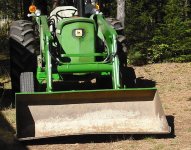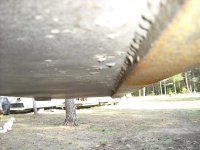Yes,
@npalen resting the vertical back blade on the soil and tilting the partially opened clamshell of the bucket while back dragging is what I use to maximize the stability of the cutting depth. I think that it helps keep some (most?) of the forces in the bucket geometry.
And, yes thanks Jim, point well taken, it isn't an apples to apples comparison on many levels; empty, the T650 weighs twice as much as my PT, it has a rigid frame, has fifty percent more horsepower, and yes, is tracked, which is huge. Plus,
the Construction Attachments bucket has a 1" thick cutting edge, and weighs 1300+lbs, which are all features distinctly better for that particular job, which is nearly flat and level to begin with.
I once watched another amateur (I have zero hours in a skid steer) get a bobcat to within a whisker of rolling on the top of a 400' 20-30 degree slope; I was impressed how fast it went from "that doesn't look good" to "kill the engine, and it is time to tow". Fortunately, nobody was hurt beyond their pride. I admit that the hydraulic drive on the PTs does make them less prone to digging in. Could an expert have done better? Sure, I haven't any doubt, though I doubt an expert would have done what the amateur was attempting in the first place. I think that learning to use a piece of equipment is probably best on flat ground.
On the other hand, I did see some techniques in that video that I would like to try, and the "ultra heavy duty" build on the Construction Attachments bucket is giving me ideas of what might be altered on mine.
All the best,
Peter



